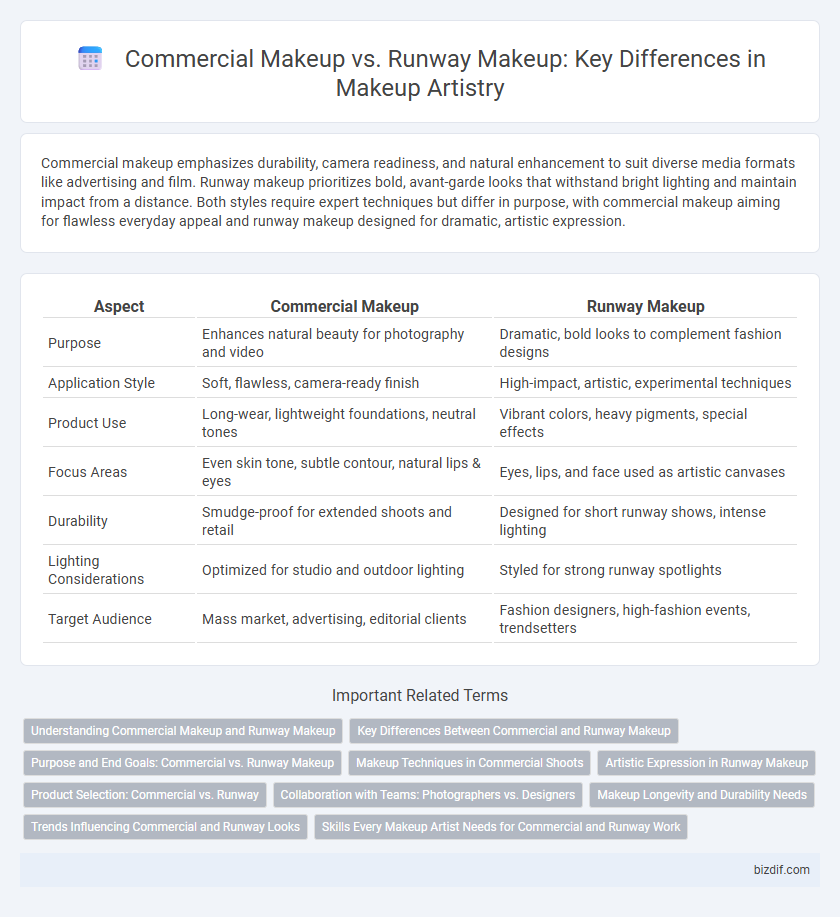Commercial makeup emphasizes durability, camera readiness, and natural enhancement to suit diverse media formats like advertising and film. Runway makeup prioritizes bold, avant-garde looks that withstand bright lighting and maintain impact from a distance. Both styles require expert techniques but differ in purpose, with commercial makeup aiming for flawless everyday appeal and runway makeup designed for dramatic, artistic expression.
Table of Comparison
| Aspect | Commercial Makeup | Runway Makeup |
|---|---|---|
| Purpose | Enhances natural beauty for photography and video | Dramatic, bold looks to complement fashion designs |
| Application Style | Soft, flawless, camera-ready finish | High-impact, artistic, experimental techniques |
| Product Use | Long-wear, lightweight foundations, neutral tones | Vibrant colors, heavy pigments, special effects |
| Focus Areas | Even skin tone, subtle contour, natural lips & eyes | Eyes, lips, and face used as artistic canvases |
| Durability | Smudge-proof for extended shoots and retail | Designed for short runway shows, intense lighting |
| Lighting Considerations | Optimized for studio and outdoor lighting | Styled for strong runway spotlights |
| Target Audience | Mass market, advertising, editorial clients | Fashion designers, high-fashion events, trendsetters |
Understanding Commercial Makeup and Runway Makeup
Commercial makeup emphasizes flawless, camera-ready looks designed for advertising, television, and print media, focusing on enhancing features to suit close-up shots and varying lighting conditions. Runway makeup prioritizes bold, artistic, and statement-making designs that complement high-fashion clothing during live shows, often using dramatic colors and texture to stand out on stage. Understanding the distinct objectives and techniques in commercial and runway makeup is essential for makeup artists to tailor their approach effectively to each industry's requirements.
Key Differences Between Commercial and Runway Makeup
Commercial makeup emphasizes flawless, natural-looking skin with subtle enhancements to appeal to a broad audience across media such as TV commercials, print ads, and digital campaigns. Runway makeup prioritizes bold, dramatic, and highly creative looks designed to capture attention and complement avant-garde fashion during live fashion shows. Techniques in commercial makeup focus on longevity and camera-friendly finishes, while runway makeup often incorporates exaggerated features and vibrant colors to ensure visibility from a distance under strong lighting.
Purpose and End Goals: Commercial vs. Runway Makeup
Commercial makeup is designed to enhance a model's features for close-up shots, ensuring flawless skin and perfect lighting for advertisements and beauty campaigns. Runway makeup prioritizes bold, dramatic looks that create visual impact under bright stage lights and from a distance, often reflecting the designer's vision and seasonal theme. The end goal of commercial makeup is to produce clean, camera-ready images, while runway makeup aims to complement fashion pieces and captivate live audiences.
Makeup Techniques in Commercial Shoots
Commercial makeup techniques emphasize flawless, natural-looking finishes that withstand high-resolution photography and various lighting conditions, using lightweight foundations and subtle contouring to enhance facial features without overpowering them. Brightening agents and dewy textures are often applied to create a radiant, camera-ready complexion, while products are selected for long wear and transfer resistance. Precision in detail is crucial to ensure the makeup appears polished on screen and in print, aligning with the commercial goal of appealing to a broad audience and showcasing products effectively.
Artistic Expression in Runway Makeup
Runway makeup prioritizes bold artistic expression, using avant-garde techniques and dramatic color palettes to create visually striking looks that complement high-fashion designs. This style often incorporates exaggerated features and unconventional materials, aiming to convey a thematic narrative or brand identity during fashion shows. Commercial makeup, in contrast, emphasizes natural enhancement and versatility for mass media appeal and everyday wear.
Product Selection: Commercial vs. Runway
Commercial makeup prioritizes long-lasting, high-coverage products such as full-coverage foundations, waterproof mascaras, and matte lipsticks designed to withstand studio lighting and close-up shots. Runway makeup emphasizes bold, dramatic products including vibrant pigments, heavy contouring palettes, and lightweight, luminescent formulas to enhance facial features under dynamic runway lights. Both approaches require specific product formulations tailored to distinct environments and visual demands.
Collaboration with Teams: Photographers vs. Designers
Commercial makeup artists collaborate closely with photographers to ensure lighting, angles, and camera settings highlight the model's features flawlessly for print and digital media. Runway makeup artists partner directly with fashion designers to create looks that complement the clothing lines, emphasizing bold, innovative styles that maintain cohesion with the show's theme. This teamwork requires precise communication and adaptability to meet the distinct visual demands of photography versus live audience presentation.
Makeup Longevity and Durability Needs
Commercial makeup prioritizes long-lasting wear to endure extended filming sessions and varied lighting conditions, using products designed for durability and frequent touch-ups. Runway makeup demands high-impact, bold looks that must withstand intense heat, sweat, and rapid outfit changes while maintaining visibility from a distance. Both require specialized formulations, but commercial makeup focuses on subtle endurance, whereas runway makeup emphasizes resilience under physical stress and striking visual impact.
Trends Influencing Commercial and Runway Looks
Commercial makeup emphasizes flawless, camera-ready finishes designed for close-up shots, often influenced by trends favoring natural glows and versatile products like tinted moisturizers and subtle contouring. Runway makeup embraces bold, avant-garde styles that push artistic boundaries, driven by seasonal fashion trends and designers' creative visions, showcasing dramatic colors, exaggerated features, and innovative textures. Both commercial and runway looks adapt dynamically to cultural shifts, technological advances in cosmetics, and social media influences that shape consumer preferences and industry standards.
Skills Every Makeup Artist Needs for Commercial and Runway Work
Mastery of flawless application techniques and strong understanding of camera lighting are essential skills for commercial makeup artists to ensure a polished, natural look that enhances the product or brand. In contrast, runway makeup requires creativity, boldness, and speed to execute dramatic, eye-catching designs that withstand intense runway lights and fast-paced show environments. Both commercial and runway makeup artists must excel in color theory, skin type analysis, and product knowledge to adapt their work to diverse clients and settings.
Commercial makeup vs Runway makeup Infographic

 bizdif.com
bizdif.com